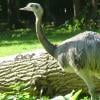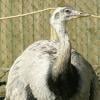Like ostriches and emus, the rhea is flightless and uses its long powerful legs to escape from predators. Living in flocks of 30 or more, rheas roam the vast pampas grasslands in search of grass seed, roots and fruits. However, they are also known to boost their diets with protein rich meals such as fledgling birds, insects and small reptiles.
The rhea is the largest bird in the Americas.
Found in Brazil, Bolivia, Paraguay, Uruguay and Argentina, the Greater Rhea is in decline due to hunting for eggs, meat and skins. It is also losing much of its natural environment as larger areas of land are turned into commercial farmland and cattle ranching.
During breeding, females lay their eggs in a communal nest, which is no more than a scrape in the ground. A clutch of up to 50 eggs is laid, after which the females leave the males to incubate the eggs, which usually takes around 35 to 40 days. On hatching, the male will also take full parental care of the chicks until they are old enough to look after themselves.
ConservationStatus
Least Concerned
Near Threatened
Vulnerable
Endangered
Critically Endangered
Extinct In The Wild




